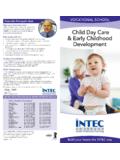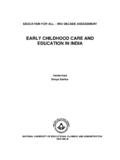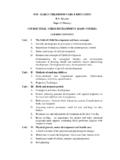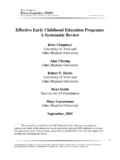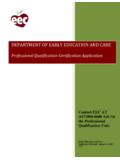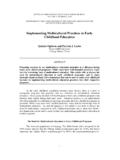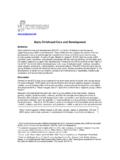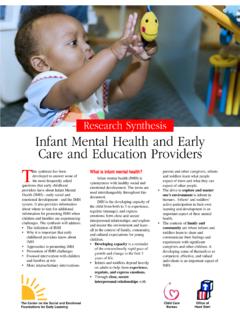Transcription of Early Childhood Education and Care Policy in …
1 Background ReportOECD Thematic Review of Early Childhood Education andCare PolicyEarly Childhood Education andCare PolicyinDenmark2 Title: Early Childhood Education and care Policy in Denmark Background ReportPublished by:The Ministry of Social Affairs in consultation with the Ministry of :ad hoc Translat rservice, :2000 ISBN:87-7546-020-3 The Ministry of Social Affairs and the Ministry of Education have authorized the OECD permission toinclude the background report on the OECD Internet Home report may be cited with clear statement of any matters concerning this report, please contact:The Ministry of Social AffairsHolmens Kanal 22DK-1260 Copenhagen KPhone:+4533929300 Fax:+45932518E-mail: Ministry of EducationFrederiksholms Kanal 21DK-1220 Copenhagen KPhone:+4533925000 Fax:+4533925547E-mail: 6 General information about 7 Section I.
2 Definitions, Contexts, and Current 9 ECEC .. 9 Social initiatives in relation to children, young people and families in general . 9 ECEC facilities offered under the act on social 11 Facilities offered under the act on primary and lower secondary Education .. 21 Number of children and coverage rates for various age groups .. 24 Other facilities offered to families with small children .. 27 Financial 28 Section II. Policy 30 The quality of day- care 30 Quality development in the public school system .. 36 Capacity: guaranteed places/waiting 36 New Danes .. 38 Section III. Policy 43 Programme content and 50 Family engagement and 51 Funding and 52 Section IV. Evaluation and 55 Section V. Concluding comments and 6245 ForewordThis report has been prepared as part of an OECD project concerning Early Childhood Education andCare Policy .
3 The following countries participate in the project: Denmark, Sweden, Norway, Finland,the Netherlands, Belgium, Portugal, Italy, the Czech Republic, the United Kingdom, the United Statesand Australia. An expert group consisting of five people have visited Denmark in connection with report has been prepared on the basis of the 'Questions to guide the Preparation of the BackgroundReport' issued by the preparation of the report for the OECD concerning Early Childhood Education and care inDenmark has been coordinated by the Danish Ministry of Social Affairs in consultation with theMinistry of Education and Jytte Juul Jensen of the College for Social care and om social service = serviceloven: Social Services ActDagtilbud: The overall term used forall public day- care facilitiesfor children under the SocialServices Act, comprising.
4 Kommunal dagpleje(municipal day care ), kommunale og selvejendedaginstitutioner(municipal and independent day- care facilities) andpuljeordninger(private facilitiesbased on local-authority grants).Kommunal dagpleje(Municipal childminder arrangement):Dagplejere(childminders) employed bythe local (playrooms), which are facilities shared by all municipal childminders,are operated in relation to the municipal childminder (day- care facilities): vuggestuer,b rnehaver,aldersintegrerede :cr chesB rnehaver: kindergardensAldersintegrerede institutioner: age-integrated facilitiesFritidshjem: after-school centresS rlige dagtilbud: Special day- care facilities for children with permanently and considerably reducedmental or physical : Childminder employed by a local authorityP dagog: Employee with relevant Education employeed in a day- care facility = child and youtheducatorP dagogmedhj lper.
5 Employee without relevant Education employed in a day- care facility = nurseryand childcare assistantsPuljeordninger: Schemes under which private facilities are operated on the basis of agreements with alocal addition there are:Fritvalg-ordninger: Free-choice schemes. Parents are offered grants for private care of children fromthe age of 24 weeks until they begin in a pre-school class at a primary school. bne p dagogiske tilbud: Open educational arrangements for children in private : Centres where parents can take children they look after at home to play with om folkeskolen = folkeskoleloven: Act on primary and lower secondary Education = theFolkeskole :School-based leisure-time facility = SFO facilitiesB rnehaveklasse:Optional one year pre-school classFolkeskole:Public primary and lower secondary school7 General information about DenmarkDenmark is one of the oldest nations in Europe, located in the northern part of Europe.
6 The system ofgovernment is based on a democratically elected parliament, the head of state being the monarch. Themost important political bodies are theFolketing(the Danish parliament and the legislative power inDenmark), and theregering(government, ie the prime minister and other ministers with various fieldsof responsibility), which has the executive Danish Constitution dates from 1849 and has thus been force for 150 years. This Constitution,which has only been subject to minor amendments over the years, forms the basis for the Danishdemocratic 179 members. Two of the members are elected on the Faroe Islands and two areelected in Greenland. The members of the Folketing are elected in general elections which as aminimum must be held every four living standard in Denmark is high by international standards and the gap between rich and poor issmaller than in many of the countries with which Denmark is traditionally covers an area of 43,000 km consisting of the peninsula of Jutland (30,000 km ) and 406islands (13,000 km ) of which 80 are inhabited (1998).
7 The biggest islands are Zealand - with thecapital Copenhagen - Funen and Lolland-Falster. These islands are interlinked by number of inhabitants is million, and the population density is about 120 per square are about 290,000 foreign immigrants in Denmark. In addition there is a small German minorityin southern Jutland. The language is Danish throughout the country, and the vast majority of thepopulation have been baptised into the established protestant church. Denmark is therefore ratherhomogeneous both in national and cultural to and emigration from Denmark have undergone changes during the last thirty between Denmark and other countries in Europe that resemble Denmark socially andeconomically has balanced throughout this period.
8 On the other hand the number of immigrants fromcountries with completely different backgrounds, in particular Turkey, the former Yugoslavia and Asia(especially Pakistan), has been increasing. In the entire period the number of immigrants has exceededthe number of emigrants. The proportion of foreign nationals in Denmark has therefore beenincreasing and on 1 January 2000 foreign immigrants made up of the population. The vastmajority of these immigrants live in the three largest cities: Copenhagen, Aarhus and per cent of the population live in towns. The greater Copenhagen region has about inhabitants. The second largest city is Aarhus (215,000 inhabitants). In addition, severalmedium-sized towns are scattered throughout the per cent of all Danish children live with both their parents (1999).
9 In the 1980s and 1990sthere was a drop in the proportion of children living with both their parents. This drop has resulted inan increase in the proportion of children living with one parent only (single provider), particularly theproportion of children living with their 1 Overview of the number of children living with both parents, one parent or no parentChildren living with both parents, one parent or no parent198019911999 Children living with both their parents1,057,185824,351853,618 Children living with one parent only236,238250,135263,867 Single mother127,260144,658156,423 Single father16,83319,41818,560 Mother in new relationship79,51874,94879,367 Father in new relationship12,62711,1119,517 Children not living with any of theirparents25,86115,23215,003 Total1,319,2841,089,7181,132,488 Source.
10 Danmark Statistik, Statisktiske Efterretmomger. Population and elections. Household and family statistics 1991 and1998, and special statement for the country is divided into 14 counties (amter)with population figures ranging fromabout 45,000 to about 632,000 and 275 municipalities (kommuner) with population figures rangingfrom about 3,100 to 282,100. Two municipalities do not belong to any county: Copenhagen with about488,999 inhabitants and Frederiksberg with about 90,000 inhabitants. Local authorities haveconsiderable and regional authorities are responsible for approximately 70 % of governmental activities,despite the fact that they only receive about 30 % of taxes and excises. The difference is made up bycentral government grants.










